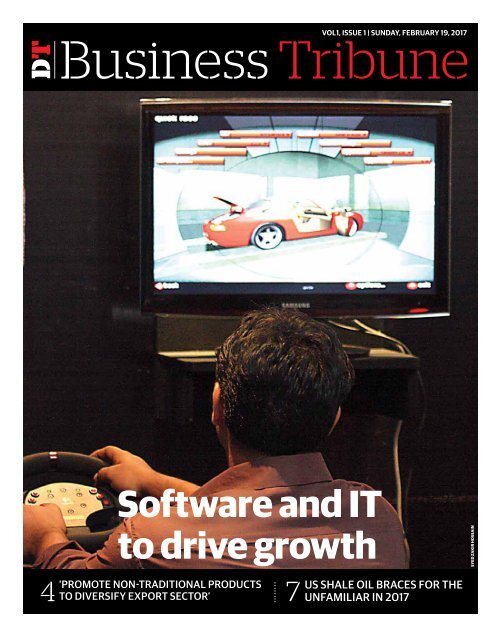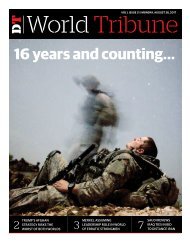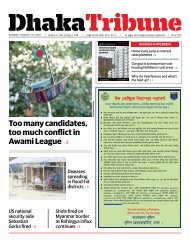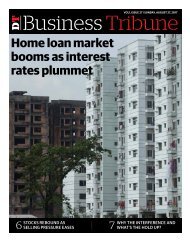Business Supplement Vol-1
Create successful ePaper yourself
Turn your PDF publications into a flip-book with our unique Google optimized e-Paper software.
DT<br />
VOL1, ISSUE 1 | Sunday, February 19, 2017<br />
<strong>Business</strong> Tribune<br />
Software and IT<br />
to drive growth<br />
Syed Zakir Hossain<br />
4<br />
‘Promote non-traditional products<br />
US shale oil braces for the<br />
to diversify export sector’ 7 unfamiliar in 2017
2<br />
Sunday, February 19, 2017<br />
DT<br />
Week in Review<br />
Bangladesh moves up nine notches on the<br />
Index of Economic Freedom<br />
Bangladesh moved nine notches up in the Index of Economic Freedom this year despite concerns about the rule of law and<br />
property rights. The 2017 Index of Economic Freedom report was published by Heritage Foundation on Thursday. The country<br />
scored 55 points and ranked 128th among 186 countries in terms of economic freedom, up 1.7 points compared to the last<br />
year’s ranking. In 2016 Bangladesh ranked 137th among 178 economies with 53.3 points. Among other South Asian countries,<br />
Nepal ranked 125th, Sri Lanka 112th, Bhutan 107th, India 143rd, Pakistan 141st and the Maldives 157th. Globally, Hong Kong tops<br />
the list scoring 89.8 points followed by Singapore, New Zealand, Switzerland and Australia. “Bangladesh has made notable<br />
success in government spending, fiscal and tax policy, while the concerns remain regarding rule of law, freedom of doing<br />
business and openness of market. But in economic freedom status it is mostly not free,” said the report.<br />
Geo-economic talks focuses on<br />
India’s anti-dumping duty<br />
India’s anti-dumping duty on Bangladesh’s<br />
jute and demonetisation<br />
of rupees have made a big dent in<br />
the export of jute products to the<br />
neighbouring country. The issue came<br />
up while Bangladesh State Minister<br />
for Foreign Affairs Shahriar Alam met<br />
Indian State Minister of External Affairs<br />
MJ Akbar on Monday on the sidelines<br />
of the “Indian Geoeconomic Dialogue”<br />
being held in Mumbai. The two ministers<br />
noted that tremendous progress was<br />
made in almost all sectors of cooperation<br />
between Bangladesh and India,<br />
including connectivity, power, trade and<br />
commerce, security, cultural exchange,<br />
tourism and people-to-people contact, a<br />
press release said.<br />
Govt to procure two LNG carrier<br />
vessels<br />
The government has decided to procure<br />
two new Liquid Natural Gas carrier vessels<br />
for transporting LNG after launching<br />
the country’s first ever LNG-import<br />
terminal at Moheshkhali in Chittagong.<br />
A non-binding Memorandum of<br />
Understanding (MoU) has been signed<br />
between the representatives of Bangladesh<br />
Shipping Corporation and Chinese<br />
Institute of Maritime and Offshore<br />
Engineering HB Co LTD at the secretariat<br />
on Tuesday. After the signing ceremony<br />
Shipping Minister Shajahan Khan said:<br />
“The capacity of each carrier vessel is to<br />
be 40,000 cubic metre which will help<br />
ease transportation of LNG.”<br />
Tofail urges India to drop trade<br />
barriers<br />
Commerce Minister Tofail Ahmed<br />
on Thursday called upon the Indian<br />
government to take necessary measures<br />
to remove tariff and non-tariff barriers to<br />
boost export to the neighbouring country.<br />
Despite a duty-free market access to<br />
India, Bangladesh’s export to the country<br />
is very small when it comes to imports.<br />
According to the latest data, in the fiscal<br />
year 2015-16, Bangladesh earned $690<br />
million from India, exporting several<br />
products while Bangladesh imported<br />
products worth $5.45 billion. “India offers<br />
Bangladesh duty-free market access<br />
for all products except tobacco, arms and<br />
alcohol, but due to tariff and non-tariff<br />
barriers, Bangladesh’s exports to India<br />
have not reached a desired level,” Tofail<br />
Ahmed said while addressing the inaugural<br />
of Indo-Bangla Trade Fair in Dhaka.<br />
Traders: Red meat to sell at Tk300<br />
per kg, if demands fulfilled<br />
Red meat traders in Dhaka have promised<br />
that they will sell meat at Tk300<br />
a kilogramme if the government eases<br />
complications over importing Indian<br />
cattle, and stops extortion and unsanctioned<br />
taxes at cattle markets, especially<br />
Gabtoli. They made the commitment at<br />
a press conference jointly organised by<br />
Dhaka Metropolitan Meat Merchants<br />
Association (DMMMA) and Bangladesh<br />
Meat Merchant Association in Dhaka on<br />
Friday, the fifth day of their week-long<br />
strike enforced on February 13. The<br />
announcement came just two days<br />
before a meeting between the traders,<br />
Commerce Ministry and Dhaka North<br />
City Corporation (DNCC), when they will<br />
decide about the strike.<br />
Tourism park planned on island in<br />
Naf River<br />
BEZA has targeted to bring 2.8m tourists<br />
by 2020 to the island located at Teknaf<br />
upazila under Cox’s Bazar. As part of the<br />
government initiative to boost tourism,<br />
Bangladesh Economic Zones Authority<br />
(BEZA) has planned to develop a new<br />
tourism park in the island of the Naf River.<br />
The new venture – Naf Tourism Park – will<br />
come into being in the middle of the river<br />
that divides Myanmar and Bangladesh.<br />
BEZA has targeted to bring 2.8m tourists<br />
by 2020 to the island located at Teknaf<br />
upazila under Cox’s Bazar.<br />
Demand for plastic goods<br />
industrial park in Keraniganj<br />
While Industries Minister Amir Hossain<br />
Amu said the work of an industrial park<br />
for the plastic sector in Munshiganj is<br />
to be completed by 2018, the industry<br />
people demanded another in Keraniganj<br />
near Dhaka. “We are working on a project<br />
at Sirajdikhan, Munshiganj at a cost<br />
of Tk133 crore on over 50 acres of land,<br />
to be completed by 2018,” said Amu at<br />
the inauguration of the International<br />
Plastic Fair 2017 in Dhaka on Wednesday<br />
as the chief guest. The fair is being<br />
held at Bangabandhu International<br />
Conference Centre. The proposed park<br />
in Sirajdikhan is expected to create jobs<br />
for about 18,000 workers, Amu said.<br />
He emphasised the need of eco-friendly<br />
green industrialisation in the country.<br />
Petrobangla seeks $1.4bn govt<br />
support to buy LNG from Reliance<br />
Petrobangla has sought assurance from<br />
the government to pay US$1.4 billion<br />
annually as it is going to purchase 390<br />
MMCFD LNG daily from India’s Reliance<br />
Power Limited, says a source in the<br />
Finance Division. The ministry of Power,<br />
Energy and Mineral Resources yesterday<br />
forwarded a letter to Petrobangla<br />
Chairman in this regard. According to the<br />
official, Treasure and Debt Management<br />
Department under the Finance Division<br />
will look into the matter for giving<br />
assurance to pay the amount to Reliance<br />
Power Limited. “We have to calculate the<br />
county’s total credit and debt before taking<br />
the decsion,” an official said, asking<br />
not to be named. According to the letter,<br />
Petrobangla has no financial capacity to<br />
pay $1.4 billion annually to Reliance.<br />
Abul Hashem new DSE chairman<br />
Professor Abul Hashem has been<br />
elected the new chairman of Dhaka<br />
Stock Exchange (DSE). The premier<br />
bourse, in a media release today, said<br />
he had been elected at a meeting of the<br />
DSE board of directors. Earlier, he had<br />
served as a director of DSE from 2010.<br />
Dr Abul Hashem is working as an honorary<br />
professor of the Dhaka University<br />
Accounting and Information Communication<br />
Department.<br />
NBR: Variations in tax card system<br />
likely<br />
The National Board of Revenue (NBR)<br />
is working on bringing variations in the<br />
tax card system, which it delivers for<br />
honoring top taxpayers in different<br />
sectors recognising their contributions<br />
to the national exchequer in coming<br />
days. “We need revenue for implementation<br />
of vision 2021 and 2041 set by the<br />
government. To mobilise revenues and<br />
encourage honest taxpayers, the NBR<br />
has already increased the number of tax<br />
cards and brought variations in the criteria.<br />
More variations will be brought in future,”<br />
NBR Chairman Md Nojibur Rahman<br />
said on Wednesday. Remittance earnings<br />
saw 2.50% growth in the year 2015 from<br />
$14.94 billion in the year 2014. •<br />
Corporate News<br />
REHAB has recently awarded Sanmar Properties Limited for its contribution to real estate industry, said<br />
a press release. The company’s chairperson, Mashuk Huck received a crest from Engineer Mosharraf<br />
Hossain, Minister for Housing and Public Works<br />
Walton has recently opened a new plaza at BCS Computer City, said a press release. President of BASIS,<br />
Mostafa Jobber and film actor Ilias Kanchan have inaugurated the plaza
International<br />
3<br />
Sunday, February 19, 2017<br />
DT<br />
Emerging market funds get rare bit of good news<br />
• Reuters Breakingviews<br />
Ashmore is giving emerging market<br />
funds a spot of good news. The<br />
developing economy specialist is<br />
seeing rising profits and demand<br />
for its products. That’s heartening,<br />
given the triple threat of Trumpian<br />
protectionism, Federal Reserve<br />
rate rises and the steady pressure<br />
on fees.<br />
Ashmore’s results come at a<br />
tough time for rival Aberdeen Asset<br />
Management, which saw 10bn<br />
pounds of outflows in the three<br />
months to December. Emerging<br />
market assets look particularly<br />
fragile: US President Donald<br />
Trump’s election and promise to<br />
“make America great again” should<br />
make funds flow from emerging<br />
markets to developed ones, if protectionist<br />
policies and a rising dollar<br />
spur faster rate rises.<br />
So far this isn’t happening. Ashmore’s<br />
assets under management<br />
were relatively flat for the sixmonth<br />
period to the end of December<br />
but up 5% in the year, while operating<br />
profit rose 33%. Although<br />
Trump’s presidency has generated<br />
A man seen walking past a stock brokerage<br />
a lot of alarm, returns on the $9tn<br />
of negative-yielding developed<br />
economy debt are still ghastly. EM<br />
debt isn’t massively expensive: the<br />
spread on the JPMorgan EMBI hard<br />
currency index is still more than 1<br />
percent above its level in 2013. And<br />
the premium offered by EM debt<br />
over developed ones could fall as<br />
risk-free rates rise.<br />
Reuters<br />
Ashmore also looks resilient to<br />
the other big threat - the onslaught<br />
of passive management and investor<br />
preference for low-fee products.<br />
Some 91% of its funds beat<br />
benchmarks in the six months to<br />
the end of December. The range of<br />
investments and performance in<br />
emerging economies should make<br />
outperformance easier. And, even<br />
as passive managers eat their way<br />
into developed assets, less than<br />
10% of emerging ones are yet captured<br />
by benchmark indices.<br />
How much longer can such<br />
trends last? Trump is unpredictable,<br />
and may reverse course if<br />
cornered – though the pain of the<br />
fallout will depend on the speed<br />
of tightening. As passive funds<br />
reach saturation point in developed<br />
economies, they will train<br />
their sights more on the untapped<br />
pool of emerging ones. Smart beta<br />
funds, a halfway house been active<br />
and passive management, may be<br />
better at matching active manager<br />
performance.<br />
Ashmore is now trading at<br />
nearly 17 times forward earnings,<br />
versus a sector average of 13,<br />
according to Eikon. That reflects<br />
Ashmore’s relative strength, but<br />
ignores the first rule of investing:<br />
past performance is no guarantee<br />
of future results. •<br />
Corporate News<br />
IPDC Finance Limited has recently announced the winners of its Valentine’s day offer, said a press<br />
release. The lucky winners were Nabila Esha, Promi Faria, Mashroor Faiyaz Khan, Adiba Samantha<br />
Parvez and Tazrian Binte Zaman<br />
Biman has recently held a daylong training workshop for the journalists covering aviation sector, said<br />
a press release. Director (Administration) of Biman, Md Belayet Hossain was present at the workshop<br />
among others<br />
Microtrade Food and Beverage Limited has recently been launched in Dhaka, said a press release. The<br />
company’s managing director, S Md Jashimuddin Chisty was present on the occasion<br />
Robi has recently hired Havas Media Bangladesh as its media agency, said a press release. CEO of Robi,<br />
Mahtab Uddin Ahmed and chairperson of HAVAS Media Bangladesh, Faridur Reza Sagar were present<br />
on the occasion
4<br />
Sunday, February 19, 2017<br />
DT<br />
Interview<br />
‘Promote non-traditional products<br />
to diversify export sector’<br />
Abdus Salam Murshedy, president of Exporters Association of Bangladesh (EAB),<br />
discusses the merits of promoting the export of non-traditional products in an exclusive<br />
interview with the Dhaka Tribune's Ibrahim Hossain Ovi<br />
How can Bangladesh diversify<br />
export products?<br />
The government has to offer<br />
lucrative options to promote<br />
export of non-traditional products<br />
to diversify the sector as well<br />
as reduce the dependency one<br />
particular product.<br />
In order to do so, the first step<br />
would be identifying the products<br />
and industries that have export<br />
potential. Following that, the government<br />
has to formulate policies<br />
and create the environment – proper<br />
infrastructure, incentives, reinvestment<br />
facilities, tax holiday,<br />
special rates, etc – in which those<br />
industries can flourish.<br />
The ready-made garment<br />
(RMG) is a great example of<br />
how government support and<br />
incentives can develop an industry<br />
with tremendous export potential.<br />
The RMG industry currently<br />
contributes to around 82% of<br />
the country’s total annual export<br />
and employs nearly 4.4 million<br />
people.<br />
But that means our export sector<br />
mostly dependent on a single<br />
industry. To overcome that<br />
dependency, the government is<br />
giving high priority to the diversification<br />
of export products in the<br />
Seventh Five-Year Plan.<br />
Creating employment requires<br />
investment, but we are not seeing<br />
any new investments being made<br />
in the country.<br />
Yes, especially in the manufacturing<br />
sector, even though the<br />
current political environment is<br />
stable. This is because there is no<br />
specific policy to ensure power and<br />
gas supply in the industries. That<br />
has to be ascertained to bring in<br />
new investments in the manufacturing<br />
sector.<br />
Does our monetary policy favour<br />
the export sector?<br />
Not really. As a leader of the export-oriented<br />
industries in the<br />
country, I expected a separate direction<br />
for the sector to be set in the<br />
monetary policy, but that did not<br />
happen. The policy should have a<br />
higher target for credit growth as it<br />
makes getting the expected funds<br />
for investment easier.<br />
To bring in more investment, we<br />
need a monetary policy that would<br />
make funds available for the manufacturing<br />
sector.<br />
Abdus Salam Murshedy discussing the prospects of non-traditional products<br />
I expected a separate direction for the sector to be set in the<br />
monetary policy, but that did not happen. The policy should<br />
have a higher target for credit growth as it makes getting the<br />
expected funds for investment easier<br />
What should the government do to<br />
encourage new investment?<br />
Investors – whether they are small<br />
or big, experienced or new – want<br />
all the resources and facilities<br />
that they need available within a<br />
certain period of time at a certain<br />
place when they invest in an industry.<br />
The government has to ensure<br />
precisely that; in order to bring in<br />
both local and foreign investments,<br />
the government must ensure onestop<br />
services within a short span of<br />
time.<br />
What are the major challenges<br />
here in running a business?<br />
Compared to our competitors, the<br />
infrastructure cost is higher in<br />
Bangladesh. The major challenges<br />
are the unavailability of uninterrupted<br />
gas and power supplies to<br />
the industries, higher gas and<br />
power prices, and the current port<br />
capacity which requires improvement.<br />
What should we do to explore new<br />
market?<br />
Both the manufacturers and the<br />
government have to concentrate<br />
on market exploration. The<br />
manufacturers have to take part<br />
photo: Courtesy<br />
in different trade shows around<br />
the world to attract buyers and<br />
brands. The government has to<br />
engage commercial counsellors in<br />
different countries to promote our<br />
products.<br />
Does Bangladesh have enough<br />
skilled workers to produce highend<br />
products?<br />
No. We need more skilled workers<br />
in the export-oriented industries<br />
to produce high-end products, particularly<br />
in the RMG sector where<br />
currently there is a 25% shortage of<br />
skilled workers.<br />
In order to train more skilled<br />
workers, our education system has<br />
to be upgraded and made industry-oriented.<br />
The government can<br />
also invest in research and training<br />
to develop skilled manpower, as<br />
can the manufacturers. •
Special<br />
5<br />
Sunday, February 19, 2017<br />
DT<br />
Software and IT-enabled services<br />
to drive Bangladesh's growth<br />
We have the<br />
ability to develop<br />
international<br />
standard<br />
software and<br />
provide the<br />
best quality of<br />
services, but it is<br />
very unfortunate<br />
for the sector<br />
that it does<br />
not get proper<br />
cooperation from<br />
Bangladeshi<br />
businesses<br />
or sufficient<br />
support from the<br />
government<br />
• Ibrahim Hossain Ovi<br />
Bangladesh software and information<br />
technology enabled services<br />
(ITES) industry has emerged as a<br />
very potential sector to enlarge<br />
the export basket as well as create<br />
more jobs for young graduates.<br />
The software and info tech industry<br />
is one of the key sector that<br />
can help achieve a middle-income<br />
status by 2021.<br />
Bangladesh has set the target to<br />
upgrade its status to a middle-income<br />
country by 2021. In achieving<br />
the target, employment generation<br />
is key which will ensure employment<br />
for the fresh graduates.<br />
Software and ITES, the emerging<br />
industry, can act as a catalyst<br />
for the purpose. In Bangladesh,<br />
there are about 17,00 IT companies<br />
working on software development<br />
for both local and foreign clients.<br />
By exporting software and computer<br />
services, Bangladesh earned<br />
A man working on his computer at a tech show in Dhaka<br />
$154 million last year. However, the<br />
BASIS data showed that the actual<br />
earnings from the export stood at<br />
$598 million, while outsourcing<br />
injected over $100 million into the<br />
country.<br />
Looking into the Bangladesh<br />
export basket, it is seen that clothing<br />
products have largely occupied<br />
the export volume. The sector employed<br />
over 4.4 million people, of<br />
which 80% are women, mostly<br />
from rural areas.<br />
In the last fiscal year, RMG sector<br />
earned over $28 billion, which<br />
is over 82% of Bangladesh’s total<br />
export earning of $34 billion.<br />
The sector enjoys policy support<br />
including cash incentives and<br />
duty-free import of raw materials<br />
from the government for its significant<br />
contribution to the national<br />
export. On the other hand, it created<br />
dependency on the single sector<br />
for forex.<br />
Now the question is how Bangladesh<br />
can enlarge the export basket<br />
to achieve its $60 billion export target<br />
by 2021, riding on RMG, and how<br />
far it is possible to reduce dependency<br />
on the single sector despite<br />
the fact that the government has<br />
emphasised product diversification.<br />
Economists, trade analysts as<br />
well as the sector people stressed<br />
the need for promotion of new and<br />
potential sectors as they would create<br />
jobs and earn more money for<br />
Bangladesh to raise the per capita<br />
income to get the middle-income<br />
status.<br />
According to the latest data,<br />
Bangladesh’s per capita income<br />
stands at $1,466.<br />
The Bangladesh government also<br />
set the goal of making “Digital Bangladesh”<br />
through digitising all services<br />
online. It has created an opportunity<br />
for software and ITES sector.<br />
But the question remains how<br />
Bangladesh as well as the sector<br />
people can tap the opportunity? Is<br />
Syed Zakir Hossain<br />
the policy support well enough at<br />
present when it comes to boosting<br />
the business?<br />
As the size of Bangladesh economy<br />
is becoming larger, the demand<br />
for software and ITES would<br />
increase every day, paving the way<br />
for new employment.<br />
The uses of software are on the<br />
rise since the government and private<br />
sector are going to digitise all<br />
their services online.<br />
On the other hand, E-commerce<br />
is getting boosted, which would<br />
open up a new horizon of opportunity<br />
for the software sector.<br />
Software developers provide<br />
business application solutions<br />
including accounting software,<br />
human resources software, office<br />
management and security solutions<br />
to the private sector as well<br />
the government.<br />
To tap the opportunity of software<br />
and ITES sector, the government<br />
should ensure effective and<br />
investment friendly atmosphere<br />
while the financial sector has to<br />
provide easy and low rate loan to<br />
run business.<br />
Since the sector is gaining momentum,<br />
skilled manpower needs<br />
to be created in the best interests<br />
of the industry while need-based<br />
education curricula introduced.<br />
There is a strong need for research<br />
to know about the market<br />
demand and the latest trend of the<br />
industry, where the government<br />
along with the sector people have<br />
to work together.<br />
Talking to the Dhaka tribune,<br />
Shamim Ahsan, former president<br />
of Bangladesh Association of software<br />
and Information Services<br />
(BASIS) expressed the prospects<br />
and problems.<br />
“We have the ability to develop<br />
international standard software and<br />
provide best quality services, but<br />
it is very unfortunate for the sector<br />
that they are not getting proper<br />
cooperation from the Bangladeshi<br />
business people and sufficient support<br />
from the government.”<br />
The government policy support<br />
will make the sector vibrant and<br />
materialie the dream of a middle-income<br />
country, Shamim said,<br />
adding that today’s RMG industry<br />
is the best example.<br />
The BASIS has over 1,000 members,<br />
of which 70% work for developing<br />
software for local and global<br />
clients. About 100 companies make<br />
mobile apps.<br />
“Our mission is clear and it is<br />
making Bangladesh a digitised one.<br />
And software and ITES can be another<br />
vehicle to upgrade Bangladesh’s<br />
status to a middle-income<br />
country,” added the software expert.<br />
Recently, State Minister for ICT<br />
Zunaid Ahmed Palak stated that<br />
around 10 lakh people will be engaged<br />
in the sector by 2021 and the<br />
government is working together<br />
with the private sector to create a<br />
business-friendly environment for<br />
the technology sector to achieve $5<br />
billion export target from ITES export<br />
by 2021.<br />
For the current fiscal year 2016-<br />
17, the government has allocated<br />
Tk8,306 crore for the sector. The<br />
sector had Tk6,107 crore in the last<br />
fiscal year.<br />
According to the Export Promotion<br />
Bureau (EPB) data, in the<br />
last fiscal year, Bangladesh earned<br />
$151.83 million, a 14.55% up over<br />
$132.554 million a year ago. While,<br />
in the first six month of the current<br />
fiscal year, Bangladesh earned $97<br />
million, 34.94% up compared to<br />
$72 million in the same period a<br />
year ago. •
6<br />
Sunday, February 19, 2017<br />
DT<br />
Stocks<br />
WEEKLY Market Overview<br />
5590.7<br />
SUMMARY Points Change (%) Turnover (BDTmn) <strong>Vol</strong>ume (mn) Advanced issues Declined issues Unchanged Issues<br />
DSEX 5,590.7 (+) 1.42% 53,504.0 1,458.4 186 126 20<br />
CSE ASI 17,309.4 (+) 1.55% 3,180.7 104.1 186 80 27<br />
Rise in turnover signals confidence boost<br />
DSE NEWS<br />
DSEX (+) 1.42%<br />
5,520<br />
• Ibrahim Hossain Ovi<br />
The Dhaka Stock Exchange (DSE) experienced<br />
a sharp rise in turnover last week as investors<br />
poured in funds expecting gains from the<br />
year-end dividend declaration of companies.<br />
Four out of five trading sessions of the<br />
week showed positive movement. During the<br />
week, the DSE added 80 points to the previous<br />
week’s close with average daily turnover<br />
increasing to over Tk1,000cr last week.<br />
According to DSE data, weekly turnover<br />
stood at Tk5,350cr, up by 45.12% compared<br />
to Tk3,686.6cr the previous week. Average<br />
daily turnover increased to TK1,070cr from<br />
Tk737.3cr. Weekly data of DSE moved up by<br />
78 points or 1.42% to close at 5,591 points.<br />
DS30, known as the blue chip index, gained<br />
25 points or 1.26% to end at 2,028 points,<br />
while DSE Shariah index added 21 points to<br />
previous week’s closing point at 1,306 points.<br />
“Broad index of the Dhaka Stock Exchange<br />
Most Traded Price Weekly Cng<br />
LANKABANGLA 57 9.8%<br />
BARAKA POWER 49.4 12.0%<br />
APPOLLO ISPAT 23.9 4.8%<br />
IDLC FINANCE 73.4 3.2%<br />
CENTRAL PHARMA 33.5 13.2%<br />
BEXIMCO PHARMA 92.1 3.1%<br />
ACI FORMA 219.5 9.0%<br />
RSRM LTD 75.5 - 3.9%<br />
DOREEN POWER 123.1 10.0%<br />
BEXIMCO 32.4 0.0%<br />
gained close to 80 points with increased<br />
turnover showing increased confidence from<br />
investors, said LankaBangla Securities in its<br />
weekly market commentary.<br />
Most of the major sectors this week provided<br />
positive price returns. Cement, engineering<br />
and food demonstrated the largest<br />
positive movements, it added.<br />
“The market is recovering from the adjustments<br />
in prices, restoring confidence of investors,<br />
which pushed weekly turnover up,”<br />
Mohammed Rahmat Pasha, CEO of the UCB<br />
Capital Management Ltd told the Dhaka Tribune<br />
yesterday.<br />
In the last couple of weeks, the market<br />
went through massive price corrections following<br />
the release of Bangladesh Bank’s<br />
monetary policy statement which cautioned<br />
banks and financial institutions about loan<br />
diversion to capital markets. The cautionary<br />
remark referred to past instances where loans<br />
taken out on the pretext of purchasing new<br />
WEEKLY MOVEMENT OF DSEX INDEX<br />
5,620<br />
5,600<br />
5,580<br />
5,560<br />
5,540<br />
homes or cars were in fact invested in the<br />
stock market. Stock market regulators urged<br />
investors to be rational following the upward<br />
trend that started at the end of last year.<br />
Financial disclosure, which showed better<br />
earning per share than the previous year’s<br />
earnings, is another reason behind the good<br />
performance in the last year, said Rahmat.<br />
However, the merchant banker said the<br />
investors’ behaviour is not rational as they<br />
are investing funds into some companies that<br />
have not been paying dividends regularly.<br />
He urged the investors to take investment<br />
decisions based on the companies’ financial<br />
performance and transparency.<br />
The large cap sectors showed mostly positive<br />
performance throughout the week. Banks,<br />
down by 0.29%, were the only losers. Telecommunications<br />
gained by 3.26%, the highest gainer<br />
of the week, followed by Fuel at 2.14%, Engineering<br />
at 1.98%, Pharmaceuticals at 1.79%,<br />
NBFIs at 1.56% and Food Allied 1.29%. •<br />
DAY 1 DAY 2 DAY 3 DAY 4 DAY 5<br />
Dhaka Tribune has accumulated the stock market related data primarily from Dhaka Stock Exchange website. The basis of information collected was primarily from daily stock quotations and audited/<br />
unaudited reports of publicly listed companies. High level of caution has been taken to collect and present the above information and data. The publisher will not take any responsibility if any body uses this<br />
information and data for his/her investment decision. For any query please email to news@dhakatribune.com.<br />
BSC: The Board of Directors has recommended<br />
12% stock dividend for the year<br />
ended on June 30, 2016. Date of AGM:<br />
19.03.2017, Time: 11:00 AM, Venue: Shaheed<br />
Mohammad Fazlur Rahman Munshi Auditorium,<br />
Chittagong Port Area, Chittagong. Record<br />
date: 06.03.2017. The Corporation has<br />
also reported EPS of Tk. 4.94, NAV per share<br />
of Tk. 610.00 and NOCFPS of Tk. (7.71) for<br />
the year ended on June 30, 2016. EPS was<br />
Tk. 3.16 for July-September, 2016 as against<br />
Tk. 2.91 for July-September, 2015. NOCFPS<br />
was Tk. 4.62 for July-September, 2016 which<br />
was Tk. (7.72) for July, 2015-June, 2016. NAV<br />
per share was Tk. 608.00 as of September<br />
30, 2016 and Tk. 610.00 as of June 30, 2016.<br />
LANKABAFIN: The Board recommended<br />
15% cash, 15% stock dividend for the<br />
year ended on Dec 31, 2016. Date of AGM:<br />
30.03.2017, Time: 11:00 AM, Venue: will be<br />
notified latter on. Record Date: 09.03.2017.<br />
The Company has also reported Consolidated<br />
EPS of Tk. 2.87, Consolidated NAV per<br />
share of Tk. 24.16 and Consolidated NOCFPS<br />
of Tk. 9.02 for the year ended on Dec 31,<br />
2016 as against Tk. 1.53 (restated), Tk. 22.63<br />
(restated) and Tk. 10.72 (restated) respectively<br />
for same period of the previous year.<br />
RNSPIN: The Company has informed that<br />
Hon'ble High Court Division of the Supreme<br />
Court of Bangladesh has passed a judgment<br />
allowing the petition of the Company to hold<br />
the Annual General Meeting within March 31,<br />
2017 and also orally directed to proceed with<br />
all the functions relating to Annual General<br />
Meeting. Based on that the Company has<br />
informed that a meeting of the Board of<br />
Directors will be held on February 22, 2017<br />
at 3:30 PM to consider, among others, the<br />
matter of dividend and to fix pending AGMs<br />
date of the Company for the financial year<br />
ended on December 31, 2012, 2013, 2014<br />
and June 30, 2016. •<br />
Buffett drops Walmart, signalling the death of retail<br />
• Agencies<br />
Warren Buffett’s Berkshire Hathaway<br />
just sold off $900m of Walmart<br />
stock, choosing to invest billions<br />
in airline stocks instead.<br />
The sale, which leaves Buffett<br />
with nearly no shares in Walmart,<br />
comes as America’s largest traditional<br />
retailer has been rushing<br />
to catch up to Amazon and other<br />
online competitors. Amazon’s<br />
market value is now $356bn, compared<br />
with Walmart’s $298bn. Buffett<br />
last year acknowledged that<br />
traditional brick-and-mortar retailers<br />
were struggling in the face<br />
of competition from the e-commerce<br />
giant.<br />
“It is a big, big force and it has<br />
already disrupted plenty of people<br />
and it will disrupt more,” Buffett<br />
said at his annual shareholders’<br />
meeting in 2016, according to<br />
Bloomberg. Buffett’s been paring<br />
his stake in Walmart since then.<br />
He first bought shares in the retailer<br />
back in 2005.<br />
He also noted that Amazon’s<br />
competitors, “including us in a<br />
few areas, have not figured the<br />
way to either participate in it, or to<br />
counter it.”<br />
Since the end of 2014, Walmart<br />
shares have fallen 21% compared<br />
with a 119% jump in Amazon.<br />
Former Walmart CEO Mike<br />
Duke admitted in 2012 that his biggest<br />
regret as CEO was not investing<br />
more in e-commerce to better<br />
compete with Amazon.<br />
'Retailing is like<br />
shooting at a<br />
moving target'<br />
“I wish we had moved faster.<br />
We’ve proven ourselves to be successful<br />
in many areas, and I simply<br />
wonder why we didn’t move<br />
more quickly. This is especially<br />
true for e-commerce,” Duke said at<br />
the time. “Right now we’re making<br />
tremendous progress, and the<br />
business is moving, but we should<br />
have moved faster to expand this<br />
area.”<br />
While Walmart has since invested<br />
billions in e-commerce, it<br />
still holds a tiny share of the market<br />
compared with Amazon.<br />
Walmart’s online sales were<br />
$13.7bn in 2015, compared to Amazon’s<br />
$107bn.<br />
Buffett’s retail instincts have<br />
proven correct before when he<br />
correctly predicted the downfall<br />
of Sears and Kmart in 2005.<br />
“Retailing is like shooting at<br />
a moving target,” Buffett said.<br />
“Turning around a retailer that has<br />
been slipping for a long time would<br />
be very difficult. Can you think of<br />
an example of a retailer that was<br />
successfully turned around?”<br />
Sears has since closed hundreds<br />
of stores and seems to be headed<br />
for bankruptcy. Macy’s and JCPenney<br />
are also closing hundreds of<br />
stores across America.<br />
While Walmart’s footprint<br />
hasn’t shrunk, many analysts say<br />
America is still over-stored.<br />
The US has 23.5 square feet of<br />
retail space per person, compared<br />
with 16.4 square feet in Canada<br />
and 11.1 square feet in Australia —<br />
the next two countries with the<br />
highest retail space per capita,<br />
according to a Morningstar report<br />
from October. •
Analysis 7<br />
DT<br />
Sunday, February 19, 2017<br />
US shale oil braces for the unfamiliar in 2017<br />
• Reuters<br />
Pump jacks drill for oil in the Monterey Shale, California, US<br />
US shale producers are facing their<br />
first production cost increase in<br />
five years in 2017 as industry activity<br />
picks up and energy service<br />
providers hike fees to take a bigger<br />
share of the profits generated by<br />
higher oil prices.<br />
Drilling innovations over the<br />
past decade have generated a<br />
dizzying reduction in the cost of<br />
pumping oil from shale formations<br />
across the United States - the<br />
world’s largest energy consumer -<br />
triggering an energy revolution and<br />
a production boom.<br />
When that boom ended with the<br />
onset of a two-year global price war<br />
in 2014, shale producers responded<br />
with even deeper cost cuts. Technological<br />
breakthroughs allowed<br />
producers to wring more oil from<br />
the rock and halved the per-barrel<br />
price needed to turn a profit.<br />
But for the first time since 2012,<br />
shale producers will see a rise in<br />
break-even production costs this<br />
year, according to data from Rystad<br />
Energy, which surveys producers.<br />
The per-barrel costs will rise an<br />
average of $1.60 across the shale<br />
patch to $36.50.<br />
The drive to lower costs has run<br />
its course for now, and service firms<br />
are leveraging power in the more<br />
crowded oilfields, such as the Permian<br />
basin in West Texas, to eke out<br />
higher payments from producers.<br />
Firms that supply rigs, crews,<br />
technological expertise are clamoring<br />
to take back discounts they<br />
extended during the slump, in<br />
some cases asking for between 10<br />
percent and 15 percent more as the<br />
number of rigs and crews deployed<br />
in the fields rises.<br />
Producers expect that to continue.<br />
“In the Permian, activity has<br />
picked up, and going forward we<br />
would expect to see some pressure,”<br />
Chevron Corp’s Chief Executive<br />
John Watson said on an earnings<br />
call last month.<br />
Oil service providers acknowledge,<br />
however, that their price<br />
hikes may not stick until drillers<br />
generate enough demand to burn<br />
through the remaining spare capacity<br />
in the oil service sector.<br />
In a securities filing on Feb 8,<br />
service provider Baker Hughes<br />
Inc cautioned that drilling “activity<br />
needs to increase meaningfully<br />
before excess service capacity<br />
can be substantially absorbed and<br />
meaningful pricing recovery takes<br />
place.”<br />
Permanent cost savings<br />
Service inflation represents only a<br />
fraction of the expected rise in international<br />
crude prices this year. A<br />
Reuters poll of 31 analysts and economists<br />
forecast benchmark US oil<br />
prices will average $56.08 per barrel<br />
in 2017, up from $43.47 last year.<br />
Between half and two-thirds of<br />
the cost savings achieved during<br />
the oil price slump are likely to become<br />
permanent even if oil prices<br />
tick higher, according to industry<br />
experts and company estimates.<br />
Shale companies deployed more<br />
rigs than they have done in sixteen<br />
months last week, and have steadily<br />
increased the number in the field<br />
to take advantage of crude prices<br />
that have mostly held at more than<br />
$50 per barrel since the world’s top<br />
oil exporters, both OPEC and non-<br />
OPEC, agreed to cut supplies in late<br />
November.<br />
A further rise in the oil price<br />
could quickly stir drilling activity<br />
across the United States, which<br />
would in turn accelerate service<br />
Reuters<br />
fee and labor cost inflation. That<br />
is a worrying development for an<br />
industry that has lately gotten used<br />
to costs heading only down.<br />
There were 207 hydraulic fracturing<br />
fleets at work in January<br />
across the US, up 20% from last<br />
June, according to data from Houston-based<br />
Primary Vision, which<br />
tracks oilfield service equipment<br />
usage.<br />
Pioneer Natural Resources Co<br />
has its own fracturing crews, which<br />
it hopes will help offset rising service<br />
costs elsewhere.<br />
“I believe we will be able to keep<br />
our inflation numbers down to more<br />
like approximately 5%, but the internal<br />
plan is to make sure that cost<br />
inflation is offset by our efficiency<br />
gains,” Pioneer Natural Chief Executive<br />
Tim Dove said on a post-earnings<br />
call earlier this month.<br />
Hedging against inflation<br />
Other companies have locked in<br />
contracts to insulate themselves<br />
from the rise in service and labor<br />
costs. WPX Energy, a leading<br />
shale oil producer in North Dakota<br />
and Texas, has sought to protect<br />
against price inflation through contracts<br />
for sand, stimulant, equipment<br />
and services, said CEO Rick<br />
Muncrief in an interview.<br />
Other companies including Hess<br />
Corp hope to beat the inflation forecasts<br />
with yet more efficiency gains.<br />
Hess hopes to wring more barrels<br />
out of each well with new techniques<br />
that allow it to conduct hydraulic<br />
fracturing at 60 spots along<br />
a well, up from the usual 50, president<br />
Greg Hill said on a conference<br />
call last month.<br />
In addition, using more sand<br />
and other proppants - used to keep<br />
fissures in shale rock open - in the<br />
wells should help boost production,<br />
Hill said.<br />
Oil producers can already count<br />
on many cost savings achieved in<br />
recent years, such as reductions in<br />
the time it takes to drill wells, said<br />
Gürcan Gülen, an energy economist<br />
at the Bureau of Economic Geology<br />
at the University of Texas at Austin.<br />
“Once you know better how<br />
to do things, you’re not going to<br />
change that when oil prices move<br />
higher,” said Gülen.<br />
But the possibility of more deep<br />
cost reductions are, for the most<br />
part, gone.<br />
A number of companies saw<br />
break-even costs at the wellhead -<br />
the price required to profit from oil<br />
at a new well - stagnate between<br />
the third and fourth quarters, data<br />
from Rystad Energy showed.<br />
“To certain producers, there’s<br />
a little bit of opportunity to lower<br />
costs more,” said Bill Costello,<br />
a portfolio manager at Westwood<br />
Holdings Group. “But those are few<br />
and far between.” •
8<br />
Sunday, February 19, 2017<br />
DT<br />
Advertisement


















